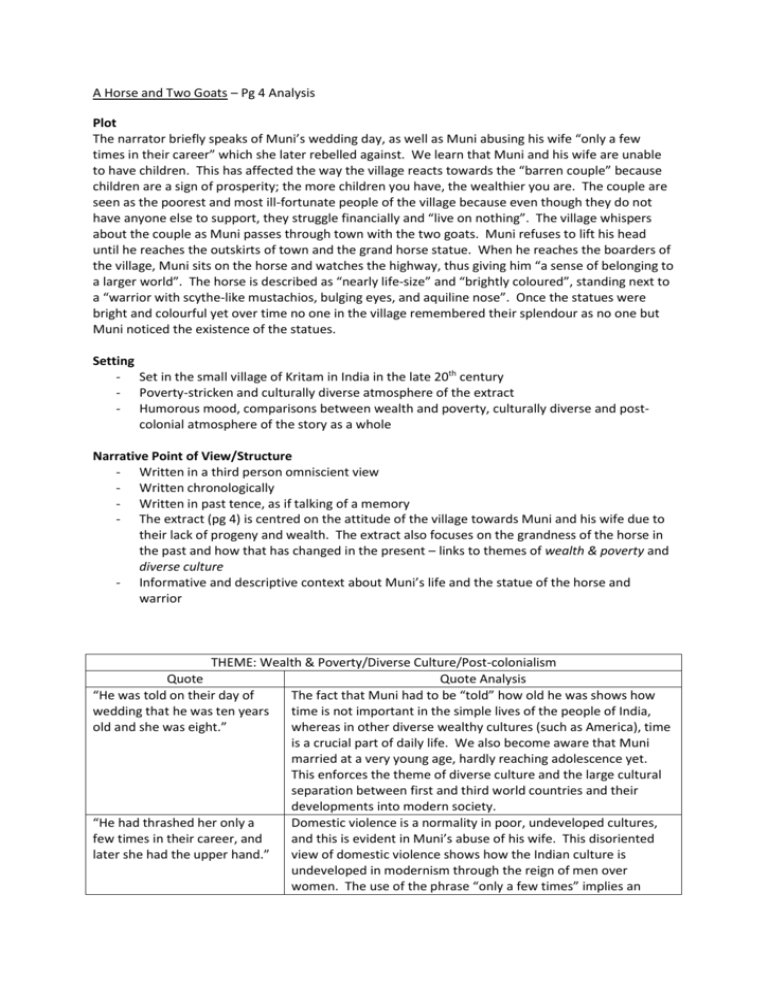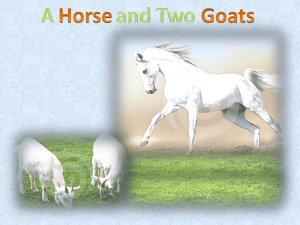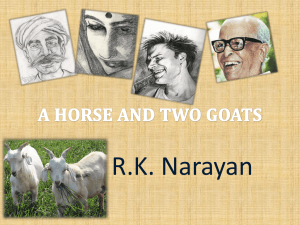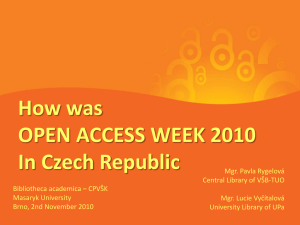A Horse and Two Goats – Pg 4 Analysis Plot The narrator briefly
advertisement

A Horse and Two Goats – Pg 4 Analysis Plot The narrator briefly speaks of Muni’s wedding day, as well as Muni abusing his wife “only a few times in their career” which she later rebelled against. We learn that Muni and his wife are unable to have children. This has affected the way the village reacts towards the “barren couple” because children are a sign of prosperity; the more children you have, the wealthier you are. The couple are seen as the poorest and most ill-fortunate people of the village because even though they do not have anyone else to support, they struggle financially and “live on nothing”. The village whispers about the couple as Muni passes through town with the two goats. Muni refuses to lift his head until he reaches the outskirts of town and the grand horse statue. When he reaches the boarders of the village, Muni sits on the horse and watches the highway, thus giving him “a sense of belonging to a larger world”. The horse is described as “nearly life-size” and “brightly coloured”, standing next to a “warrior with scythe-like mustachios, bulging eyes, and aquiline nose”. Once the statues were bright and colourful yet over time no one in the village remembered their splendour as no one but Muni noticed the existence of the statues. Setting - Set in the small village of Kritam in India in the late 20th century - Poverty-stricken and culturally diverse atmosphere of the extract - Humorous mood, comparisons between wealth and poverty, culturally diverse and postcolonial atmosphere of the story as a whole Narrative Point of View/Structure - Written in a third person omniscient view - Written chronologically - Written in past tence, as if talking of a memory - The extract (pg 4) is centred on the attitude of the village towards Muni and his wife due to their lack of progeny and wealth. The extract also focuses on the grandness of the horse in the past and how that has changed in the present – links to themes of wealth & poverty and diverse culture - Informative and descriptive context about Muni’s life and the statue of the horse and warrior THEME: Wealth & Poverty/Diverse Culture/Post-colonialism Quote Quote Analysis “He was told on their day of The fact that Muni had to be “told” how old he was shows how wedding that he was ten years time is not important in the simple lives of the people of India, old and she was eight.” whereas in other diverse wealthy cultures (such as America), time is a crucial part of daily life. We also become aware that Muni married at a very young age, hardly reaching adolescence yet. This enforces the theme of diverse culture and the large cultural separation between first and third world countries and their developments into modern society. “He had thrashed her only a Domestic violence is a normality in poor, undeveloped cultures, few times in their career, and and this is evident in Muni’s abuse of his wife. This disoriented later she had the upper hand.” view of domestic violence shows how the Indian culture is undeveloped in modernism through the reign of men over women. The use of the phrase “only a few times” implies an “Progeny, none. Perhaps a large progeny would have brought him the blessing of the gods.” “The advantage of [sitting on the horse’s pedestal] was that he could watch the highway and see the lorries and buses pass through to the hills, and it gave him a sense of belonging to a larger world.” “But none in the village remembered the splendour as no one noticed [the statue’s] existence. Even Muni, who spent all his waking hours at its foot, never bothered to look up.” almost positive view that the rate at which Muni abuses his wife is at the bare minimum compared to the average couple in India. The use of the word “career” refers to the violence as a life-long occurrence for women to be dominated by men. However, Muni’s wife later opposes his dominance, showing signs of postcolonialism. Muni and his wife are unable to have children. “Large progeny” is a sign of prosperity and wealth. Muni believes that if they had a lot of children, the gods would give their blessing. In many poor countries, children are a sign of wealth; the more you have, the wealthier you are. Muni has come to the conclusion that the reason he and his wife and struggling is because the gods have not given them blessing due to the fact they are unable to have children, thus nicknamed by the village the “barren couple”. The use of the word “perhaps” provokes the reader to contemplate the possibilities of Muni’s fate if he were able to have children. The reference to the “highway” hints at the theme of colonialism, and is symbolic of the slow progression of India into the modern world. The phrase “it gave him a sense of belonging to a larger world” is humorous towards the fact that sitting up high on the horse and being able to see more due to the height allows him to feel that the world is large. It also allows Muni to link the highway to the vastness of other diverse cultures and the possibilities of where the road may lead. The statue of the horse in some ways is reflective of Muni, for instance how no one notices the horse’s existence and no one notices Muni existence either. Both Muni and the statue had reached a climatic point in time where Muni was wealthy and the horse had a vast appearance of grandness. However, both had worn away over time and the statue over weather. The reader becomes aware that even though both Muni and the horse are at the same level, Muni doesn’t “bother to look up.” This implies that Muni still likes to believe himself to be above what he really is. Symbolism Horse: - Used to be glorious and grand, but now is worn over time and weather - Reflective of Muni and his life – both used to be wealthy, now in poverty - Symbolic of the traditions, legends, gods of India. A relic of Indian culture - Along with time, the statue has been forgotten and in a way, so has the village. - The newer generations that are becoming are less religious and more liberal. It is mentioned that “even the youthful vandals of the village left the statue alone”. The younger generations do not seem to care about the spiritual significance of the religious statue.











